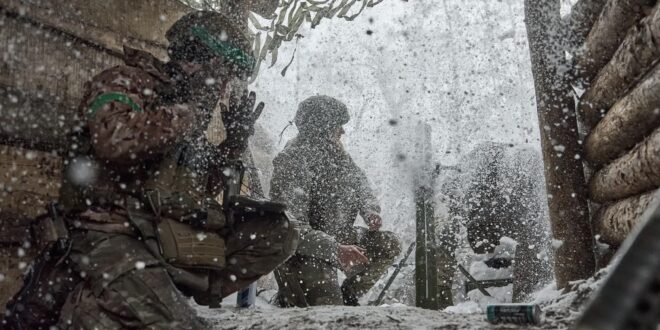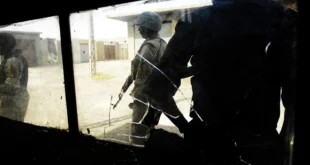“We will batter them with drones, we will conduct partisan raids in their rear. We’ll fight until we’re dead.”
by Aleksander Palikot
NEAR ROBOTYNE, Ukraine — “To put it bluntly, we barely have enough strength to defend what we gained over the summer,” Ihor said. He is a battalion commander who took part in the liberation of Robotyne, the southernmost point Ukrainian forces recaptured in the Zaporizhzhya region last year. “And we gained it with great losses.”
A stocky man of 52 with an olive-drab kaffiyeh-style scarf around his neck, he supports himself with a walking stick: The piece of shrapnel from a Russian shell that hit him during fighting for the village is still lodged inside his leg. Over the 17 months the unit spent in southern Ukraine, hardly any of his soldiers escaped harm. Half of them died or suffered wounds that made further combat service impossible, he said.
READ MORE: Ukraine is Using Unique ‘PARM 2’ Mine Against Russian Armor
Now, five months after taking Robotyne, the only road leading to it is too dangerous to drive because of the proximity of Russian forces. The roar of artillery fire and the whiz of falling shells thunders over the snow-covered steppe. Dozens of drones hanging in the sky spot almost any movement and attacks come in minutes.
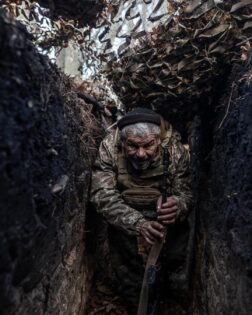
A soldier in Ukraine.
Nearly two years into their full-scale invasion of Ukraine, Russian troops are on the offensive on almost all sections of the front line, including in the Zaporizhzhya region, where Robotyne is located, backed by an economy on a war footing. Ukraine is holding ground despite uncertainty concerning Western aid, emptying ammunition stockpiles, and manpower shortage.
Halted Advance
When Ukraine’s widely anticipated counteroffensive aimed at breaking through toward Melitopol, Berdyansk, and the Azov Sea coast kicked off last June, the 65th Separate Mechanized Brigade — which includes the First Battalion, led by Ihor — was supposed to support the newly created NATO-trained and Western-equipped assault formations.
But as the Ukrainian attempt at a quick and decisive attack with tanks and armored vehicles failed almost instantly the brigade found itself at the forefront of what would turn out to be monthslong endeavors to break through a series of Russian trenches, anti-tank obstacles, and minefields known as the Surovikin Line.
Its gradual southward advance started with the seizure of a strategic hilltop south of the town of Orikhiv referred to as “Position X” due to the shape of Russian fortification there.
Russian troops held on through five assaults and were forced to retreat only after a surprise attack carried out during their shift change. Once they took it, the Ukrainians would not have held the position without ammunition left by the Russians, soldiers from the brigade told RFE/RL.
After that, several Ukrainian brigades fought their way through Russian defenses for two months before they raised the national flag in Robotyne in late August. A month later they reported a breakthrough close to the neighboring village of Verbove, but since then their movement toward Tokmak, a strategic road-and-rail hub for the way to Melitopol, has stopped.
According to Ihor, Ukraine’s push forward was halted because unlike during the successful campaigns in Kharkiv and Kherson regions in autumn 2022, Russian forces expected it and prepared for it. He said that for his brigade, fighting against echelon formations on the mostly flat terrain with insufficient air support resulted in a loss ratio of 1:5 — five Ukrainian casualties for every Russian killed or wounded in action.
“If you think that after all this we are looking forward to a cease-fire, you are dead wrong: We will fight for every inch of the ground we took back,” he said.
‘Hardly Possible’
Today “Position X” provides a viewpoint overlooking the territory reclaimed by Ukraine.
To get to their positions, most of which were recaptured from Russians, Ukrainian soldiers must walk several kilometers on foot, usually early in the morning when the visibility is low.
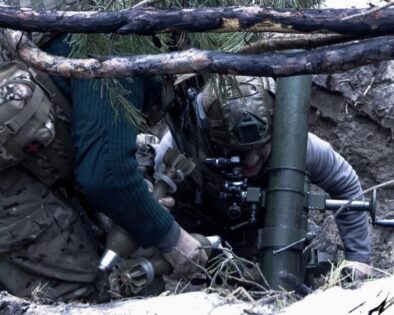
They spend days and nights in trenches and dugouts running along the shattered tree lines cutting through the flat landscape, havens that offer limited protection from artillery fire and drone-dropped munitions.
The winter in southern Ukraine is relatively warm with temperatures fluctuating around zero degrees Celsius even as late as in January. The steppe wind, however, can be piercingly cold. Lighting a campfire or turning on an electricity generator risks detection by Russian forces.
Since autumn, trenches have been plagued by swarms of mice and rats. They are crawling into soldiers’ clothing, biting fingers, and causing sleepless nights. If not suppressed, the rodent infestation can spread rat-bite fever, which can cause soldiers to vomit and even bleed from their eyes.
But these problems pale in comparison to the constant threat to life from Russian fire.
According to reconnaissance soldiers from the 65th Brigade, Russian troops assault the first line of Ukrainian defenses two or three times on “quiet” days and around 10 times on “hot” days.
The attacks are carried out not by professional soldiers but by forcefully mobilized novices and ex-convicts, often under the influence of drugs, according to Kit, a scout whose unit recently took six Russian soldiers captive.
“It’s hardly possible to fight in such conditions,” an infantryman who goes by the call sign Dym (Smoke) and recently fought against attacking Russian forces, told RFE/RL. Th Russians, he said, have an advantage in all types of weapons and “feel like they’re at home here.”
Ukrainian artillery crews and drone teams try to prevent or stop these assaults.
“Our job is to cover our boys in the first line,” a mortar-team commander known as Rikki told RFE/RL as he walked out of a tiny dugout he has been sharing for over six months with two fellow soldiers, Winston, 26, and Batya (Dad), 48.
At their position, one can tell that Ukraine’s supply of shells has dwindled just by listening: For every 10 incoming Russian shells, the Ukrainians fire one or two. The team has been firing just up to five shells per day at Russian infantry, Rikki 28, told RFE/RL, adding: “We are fighting with what we have.”
After almost two years of fighting in the area, the two sides know each other very well.
Dobrat, 25, the head of a Ukrainian tank unit, told RFE/RL that by now his team “knows the coordinates of all possible points on the enemy terrain.”
Two of his soldiers, Shakhist and Grek, both 54, counted that they have fired more than 1,000 rounds from their Soviet-era T-72 tanks. Both had been trained at a Soviet base in East Germany in the 1980s, and decades later both were mobilized shortly after Russian President Vladimir Putin, who was also stationed in East Germany in the 1980s with the KGB, launched the full-scale invasion of Ukraine on February 24, 2022.
“It’s not the most modern weapon, but it still does the job,” Grek said, adding that drones, especially kamikaze drones, pose a great risk.
Different kinds of drones have been increasingly used by both sides of the war in Ukraine due to their low cost and high accuracy, which allows pilots to target moving vehicles and infantry. They also play a vital role in the real-time observation of the battlefield and correcting artillery fire.
But flying drones in wintertime gets difficult. The batteries of popular FPV drones have shorter lifespans in lower temperatures and thus they usually fly for no more than 30 minutes. Low visibility also limits their reconnaissance capabilities, a 30-year-old drone operator with the call sign Dzhyn (Genie) told RFE/RL.
Minutes earlier, the team had lost a drone shortly after taking it up. Unlike most of the grounded drones that get jammed by Russian radio-electronic warfare systems, their drone was simply crushed by strong wind and cold temperatures.
“It went to drone heaven,” said Dzhyn’s comrade Leshiy, 33. “They were made for wedding ceremonies, not for war.”
But drones, especially those equipped with night-vision cameras, have made warfare more dangerous than ever before.
Even ground assaults are meant in part to force enemy troops to reveal their camouflaged positions to reconnaissance drones and make them vulnerable to attack from the air, soldiers from the brigade told RFE/RL.
And according to Ihor, the warfare on Ukraine’s southern steppes has reached an equilibrium impossible to break without a large number of resources or a technological leap.
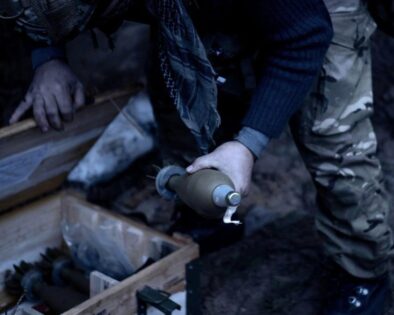
With a $61 billion package of mostly military aid stymied in the U.S. Congress and questions looming over future EU aid, it’s unclear when those resources might come — if they ever do.
‘Low’ Morale
Moreover, as the war drags on and Ukraine struggles to reform its military enlistment system, the shortage of manpower is an increasingly acute problem.
In December, the 65th Brigade was reinforced with the 57th Separate Rifle Battalion. The unit had spent the previous 13 months fighting in Bakhmut and other areas in the eastern Donbas region that have seen some of the most intense fighting of the war.
Members of the unit spoke to RFE/RL at an abandoned school after their first fights in the Robotyne area.
The 10 men, visibly exhausted and some of them in great physical pain, spoke candidly of discontent with their treatment by the military brass and army bureaucracy. Soldiers voiced anger at medical commissions, at the high-level leaders who decided to move them to the south, and at having to fight despite the losses and what they called a lack of weapons.
“Had I known how the army would treat me, I would not have joined,” said Mykola, 58, a soldier who volunteered to fight almost two years ago.
The battalion suffered heavy losses and was not given time to recover, soldiers said. Most of its members, farmers and workers from the Chernivitsi region in the west, volunteered to fight.
“Most of us joined driven by patriotism, and most are already dead,” said a soldier with the call sign Lutiy, 41.
According to Polyn, the unit’s medic, the average age of the battalion members is 47, which means most of them joined the army already with injuries and illnesses. Several men said they tried to leave the frontline positions, but the military medical commission rejected their requests. Three said they were asked, openly or through hints, to pay bribes in exchange for permission to leave the front on health grounds.
Truman, the battalion’s psychologist, told RFE/RL that the soldiers’ morale is “low” and that some have left the unit to receive psychiatric treatment.
“The uncertainty about the future adds to the pessimism,” he said.
Back at the headquarters of the 65th Brigade, Ihor remained undaunted, staring at the monitors displaying the real-time footage of the battlefield.
He said the units with good leadership and commanders who join the fight on the ground maintain better morale. He also argued that the military enlistment system has long needed reform.
“One campaign is successful, another is not,” he said. “It’s difficult to fight with no airplanes, few tanks, little artillery, and scarce ammunition, but if Plan A doesn’t work, we have Plan B and C. We will batter them with drones, we will conduct partisan raids in their rear. We’ll fight until we’re dead.”
Aleksander Palikot is a Ukraine-based journalist covering politics, history, and culture. This article first appeared in RFE/RL.
 Soldier of Fortune Magazine The Journal of Professional Adventurers
Soldier of Fortune Magazine The Journal of Professional Adventurers


